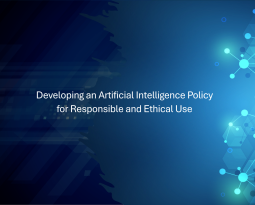Envisioning Future Cities: Harnessing Technology for Climate Adaptation
As the world grapples with the escalating impacts of climate change, the cities of the future are being envisioned as hubs of innovation and resilience through the use of technology. These forward-thinking applications, are set to transform urban living and transportation while prioritizing sustainability and climate adaptation.
Smart Sensors, AI, Drones, VR/AR
One of the most promising advancements is the integration of smart infrastructure and urban sensing technologies. By equipping buildings and infrastructure with digital sensors, cities can monitor and manage the flow of energy, water, and waste in real time. This convergence of physical and digital infrastructure enables cities to orchestrate complex systems efficiently, reducing their carbon footprint and enhancing resilience against climate-related disasters.
Artificial Intelligence (AI) is also playing a pivotal role in climate adaptation. Advanced AI models are being developed to enhance weather and climate predictions, and provide early warnings for extreme weather events. For instance, AI-powered smart sewer systems can prevent flooding during heavy rainfall, while drought-resistant crops are being developed to ensure food security in changing climates. These innovations are crucial for building resilient urban ecosystems that can withstand the challenges posed by climate change.
When we look at drones and earth observation technologies, they too are revolutionizing climate adaptation efforts. Drones equipped with advanced cameras and sensors can monitor climate risks and impacts, providing valuable data for disaster response and resource management. Earth observation satellites also offer a bird’s-eye view of environmental changes, enabling cities to track deforestation, monitor water levels, and assess the health of urban green spaces. These technologies are essential for making informed decisions and implementing effective climate adaptation strategies.
But alas, we cannot forego the use of Virtual and Augmented Reality (VR/AR) technologies. They are being leveraged to engage communities in climate adaptation initiatives as well. VR simulations can help residents visualize the potential impacts of climate change and understand the importance of sustainable practices. AR applications can guide citizens through climate-resilient urban planning, which will help foster a sense of ownership and responsibility toward their environment. Evidence has shown by involving communities in the adaptation and urban planning process, cities can build stronger, more cohesive responses to climate challenges.
eVTOL (Flying Cars)
The advent of flying cars is set to revolutionize urban planning and transportation. With the development of electric vertical takeoff and landing (eVTOL) vehicles, cities are preparing for a future where the skies become an extension of the urban landscape. Today, vertiports, revamped air traffic systems, and sustainable strategies are being planned for and eemployed to harmoniously integrate flying cars into city infrastructures. This mode of transportation promises to alleviate traffic congestion, improve urban mobility, reduce travel times, expand cargo delivery and contribute to a more sustainable urban environment. According to the OECD’s ITF Transport Outlook 2023 Report, these technologies could make cities more livable by offering flexible and efficient transportation options as long as policy measures exist to ensure these vehicles are built to contribute to the decarbonization of the transport sector.
Joby Aviation is a pioneering leader in the eVTOL sector. It was the first company to receive airworthiness approval from the U.S Air Force in December 2020, under the Agility Prime initiative, which led to further investment in developing their hydrogen-electric, vertical take-off and landing aircraft. This aircraft can complete a 523 mile flight, with water as the only by-product. It has also signed a partnership agreement with Delta Air Lines to deliver a home-to-airport air taxi service that seamlessly integrates the Joby flight into the Delta customer experience, and is working with UBER to provide ride sharing options.
But Joby is not the only key player in the eVTOL industry; other companies are also making significant strides. Archer Aviation based in San Jose, California, received their Part 145 certification from the Federal Aviation Administration (FAA) on February 8, 2024, authorizing them to conduct specialized aircraft repair services commercially. Following this, they obtained their Part 135 Air Carrier & Operator Certificate on June 5, 2024, allowing them to begin operating their on-demand air taxi service. Archer plans to launch air taxi services in New York City and Los Angeles, similar to Joby
Conclusion
In conclusion, the successful integration of modern technologies in urban settings requires cities to prioritize key initiatives and develop comprehensive implementation roadmaps. This means investing in robust digital infrastructure, fostering public-private partnerships, and promoting active community involvement. By aligning technological advancements with climate adaptation goals, future urban landscapes can exemplify sustainability and resilience.
Future cities will not solely be defined by their technological advancements but by their ability to create sustainable, resilient, and inclusive environments. Through innovative applications of new technologies and a steadfast focus on climate adaptation, we can build urban spaces that are prepared for the challenges ahead. The journey towards these cities of the future begins with a shared commitment to innovation, collaboration, and sustainability.
References
- OECD, May 24, 2023 ITF Transport Outlook 2023
- TechCrunch, October 22, 2024 Author: Rebecca Bellan “Feds clear way for EVTOL startups to bring flying vehicles to U.S. airspace“
- Federal Aviation Administration, October 22, 2024 “With New Rule, FAA is Ready for Air Travel of the Future | Federal Aviation Administration”
- Associated Press, BBC, October 22, 2024 “Flying cars are finally going to happen: The FAA just created the first new aircraft category in 80 years | Fortune
- Joby, July 11, 2024 “Joby completes landmark 523-mile hydrogen-electric flight”
- The Verge, June 5, 2024 “Archer Aviation gets the green light to operate an electric air taxi service”


